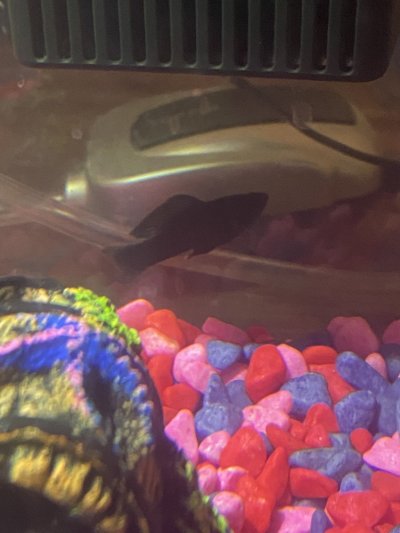Sorry if this is the wrong place. Yesterday morning I fed my fish (3 guppies and two black mollies) brine shrimp like I have been. All fish are new to the tank for about a week. Went to feed them this morning and all three were dead. Two have completely lost colouring (not sure if that’s normal or not). Does anyone know what’s happened? A few days before I got them I did a water change and put a bacteria pod in it. Idk if that affects it or not.
You are using an out of date browser. It may not display this or other websites correctly.
You should upgrade or use an alternative browser.
You should upgrade or use an alternative browser.
My 3 guppies died overnight
- Thread starter em_18
- Start date
The friendliest place on the web for anyone with an interest in aquariums or fish keeping!
If you have answers, please help by responding to the unanswered posts.
If you have answers, please help by responding to the unanswered posts.
Sorry if this is the wrong place. Yesterday morning I fed my fish (3 guppies and two black mollies) brine shrimp like I have been. All fish are new to the tank for about a week. Went to feed them this morning and all three were dead. Two have completely lost colouring (not sure if that’s normal or not). Does anyone know what’s happened? A few days before I got them I did a water change and put a bacteria pod in it. Idk if that affects it or not.
It’s also a 5 gallon tank.
Please take a read through the "unhealthy fish" sticky and give as much detail as you are able. A clear photo of the dead fish would help too.
https://www.aquariumadvice.com/forums/f17/before-posting-about-unhealthy-fish-read-this-32451.html
https://www.aquariumadvice.com/forums/f17/before-posting-about-unhealthy-fish-read-this-32451.html
Colin_T
Aquarium Advice Addict
Pictures of the dead fish (if you still have them) and remaining live ones?
How long has the tank been set up for?
What is the ammonia, nitrite, nitrate and pH of the water?
What sort of filter is on the tank?
How often and how do you clean the filter?
How often do you do water changes and how much do you change?
Do you gravel clean the substrate when you do a water change?
Do you dechlorinate the new water before adding it to the tank?
Did you feed them dry, frozen or live brineshrimp?
Did you do anything to the tank on the day before they died?
What are the tank dimensions (length x width x height)?
What is the GH (general hardness) and KH (carbonate hardness) of your water supply?
This information can usually be obtained from your water supply company's website (Water Analysis Report) or by telephoning them. If they can't help you, take a glass full of tap water to the local pet shop and get them to test it for you. Write the results down (in numbers) when they do the tests. And ask them what the results are in (eg: ppm, dGH, or something else).
How long has the tank been set up for?
What is the ammonia, nitrite, nitrate and pH of the water?
What sort of filter is on the tank?
How often and how do you clean the filter?
How often do you do water changes and how much do you change?
Do you gravel clean the substrate when you do a water change?
Do you dechlorinate the new water before adding it to the tank?
Did you feed them dry, frozen or live brineshrimp?
Did you do anything to the tank on the day before they died?
What are the tank dimensions (length x width x height)?
What is the GH (general hardness) and KH (carbonate hardness) of your water supply?
This information can usually be obtained from your water supply company's website (Water Analysis Report) or by telephoning them. If they can't help you, take a glass full of tap water to the local pet shop and get them to test it for you. Write the results down (in numbers) when they do the tests. And ask them what the results are in (eg: ppm, dGH, or something else).
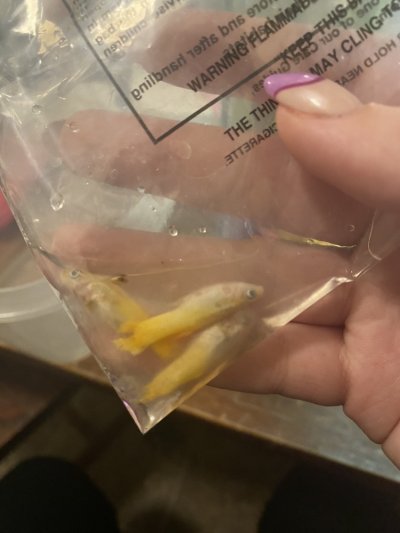
So I thought they lost colour but when I took them out the colouring is still there. I’m assuming they have been dead for 24 hours as they were fine yesterday morning no signs of anything. I’ve had this tank for 2 years but had a few sick fish that passed so I cleaned out the tank fresh. Put new water plus about 10% of the old in with the water conditioner in the proper measurements as well as a bacteria orb. I use the topfin IF20 filter with the IF-S cartridges, which is also new but I changed the filter monthly. When I clean it I usually run it with hot water. I attached a photo of the brand of frozen brine shrimp I used
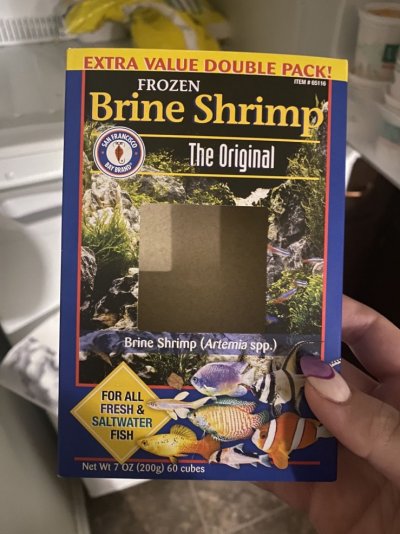
And I gravel clean with my monthly change, but I did a full clean because of my previous sick fish (from old age). Nothing was changed the day before they died! Everyone was looking normal. From a general report it says the water is medium hard but that was all the info I could find on the spot. PH of my tank is a 7.6 right now.
I am a beginner and am still learning about how to properly care for fish so please bare with me if I’m doing some things incorrectly! Excited to learn what I can do better.
Colin_T
Aquarium Advice Addict
Aiken is going to have a field day with you when he sees the info about your filter 
How long ago was the full clean, was it a week or two before the fish died?
You shouldn't change the filter media unless it starts to break down. Then you can replace it with a sponge for a different brand of filter. You also shouldn't wash filter media/ materials under tap water.
Filters develop colonies of good bacteria that help keep the water clean. The first group of beneficial bacteria eat ammonia and convert it into nitrite. More bacteria develop and eat the nitrite and convert it into nitrate. If you replace the filter media or wash it under hot water, or even cool tap water, you can kill the bacteria and then there is nothing to convert the ammonia into nitrite, and nitrite into nitrate. If that happens, you can get an ammonia spike and the fish can die. Ammonia is produced by fish food and waste breaking down in the water. If you have a new filter and feed the fish meat based foods like frozen brineshrimp, that can release a lot of ammonia into the water and cause a massive ammonia spike.
Established biological filters (filters more than 8 weeks old and that have developed the colonies of beneficial bacteria) should be cleaned once a month. You wash the filter materials/ media in a bucket of tank water and re-use the media. Tip the bucket of dirty water on the garden/ lawn outside.
Some filter companies tell you to replace the filter media every month. This is a sale's ploy so you keep giving them money. The only time you have to replace the filter materials is if they start to fall apart. Then you replace them one at a time with a sponge. You can buy sponges for different brands of filter and cut them to fit with a pair of scissors. Sponges last for years and only get replaced when they fall apart. They get squeezed out in a bucket of tank water and re-used.
-------------------
Water changes should be done once a week if possible. You can use a gravel cleaner to syphon about 50% of the tank water out and clean the substrate at the same time. then top the tank up with some dechlorinated water.
If you only do a partial water change once a month, the water quality can deteriorate during that time and when you replace some of the old water with new water, there can be a major difference in water quality that can harm or even kill the fish. It's called old tank syndrome and is common in aquariums that don't get regular water changes.
If you can't do a water change every week, then try to do it at least once every two weeks, but once a week is better. A lot of people simply do water changes every Saturday or Sunday so it's done for a week. It's a bit like cleaning the house, you do it regularly and the fish tank needs a clean regularly.
-------------------
The fish have a bit of damage to their tails and a few unusual marks that look like something tried to eat them, but they don't appear to have a disease, although more pictures might show more info. However, I think the problem might have been caused by the major clean that was done recently, a new filter (it's considered a new filter because you got rid of the old media and put new stuff in), and some frozen food. I believe you had an ammonia spike and that killed the fish.
If you can post some pictures of the remaining fish, I can check them for disease.
You should also try and get the aquarium water tested for ammonia, nitrite, nitrate and pH. Post the results in numbers and we can see if that is part or all of the problem. If you get the water tested at a pet shop and they say the water is fine, ask them what the results are in numbers and write the numbers down at the time.
How long ago was the full clean, was it a week or two before the fish died?
You shouldn't change the filter media unless it starts to break down. Then you can replace it with a sponge for a different brand of filter. You also shouldn't wash filter media/ materials under tap water.
Filters develop colonies of good bacteria that help keep the water clean. The first group of beneficial bacteria eat ammonia and convert it into nitrite. More bacteria develop and eat the nitrite and convert it into nitrate. If you replace the filter media or wash it under hot water, or even cool tap water, you can kill the bacteria and then there is nothing to convert the ammonia into nitrite, and nitrite into nitrate. If that happens, you can get an ammonia spike and the fish can die. Ammonia is produced by fish food and waste breaking down in the water. If you have a new filter and feed the fish meat based foods like frozen brineshrimp, that can release a lot of ammonia into the water and cause a massive ammonia spike.
Established biological filters (filters more than 8 weeks old and that have developed the colonies of beneficial bacteria) should be cleaned once a month. You wash the filter materials/ media in a bucket of tank water and re-use the media. Tip the bucket of dirty water on the garden/ lawn outside.
Some filter companies tell you to replace the filter media every month. This is a sale's ploy so you keep giving them money. The only time you have to replace the filter materials is if they start to fall apart. Then you replace them one at a time with a sponge. You can buy sponges for different brands of filter and cut them to fit with a pair of scissors. Sponges last for years and only get replaced when they fall apart. They get squeezed out in a bucket of tank water and re-used.
-------------------
Water changes should be done once a week if possible. You can use a gravel cleaner to syphon about 50% of the tank water out and clean the substrate at the same time. then top the tank up with some dechlorinated water.
If you only do a partial water change once a month, the water quality can deteriorate during that time and when you replace some of the old water with new water, there can be a major difference in water quality that can harm or even kill the fish. It's called old tank syndrome and is common in aquariums that don't get regular water changes.
If you can't do a water change every week, then try to do it at least once every two weeks, but once a week is better. A lot of people simply do water changes every Saturday or Sunday so it's done for a week. It's a bit like cleaning the house, you do it regularly and the fish tank needs a clean regularly.
-------------------
The fish have a bit of damage to their tails and a few unusual marks that look like something tried to eat them, but they don't appear to have a disease, although more pictures might show more info. However, I think the problem might have been caused by the major clean that was done recently, a new filter (it's considered a new filter because you got rid of the old media and put new stuff in), and some frozen food. I believe you had an ammonia spike and that killed the fish.
If you can post some pictures of the remaining fish, I can check them for disease.
You should also try and get the aquarium water tested for ammonia, nitrite, nitrate and pH. Post the results in numbers and we can see if that is part or all of the problem. If you get the water tested at a pet shop and they say the water is fine, ask them what the results are in numbers and write the numbers down at the time.
Aiken is going to have a field day with you when he sees the info about your filter
How long ago was the full clean, was it a week or two before the fish died?
You shouldn't change the filter media unless it starts to break down. Then you can replace it with a sponge for a different brand of filter. You also shouldn't wash filter media/ materials under tap water.
Filters develop colonies of good bacteria that help keep the water clean. The first group of beneficial bacteria eat ammonia and convert it into nitrite. More bacteria develop and eat the nitrite and convert it into nitrate. If you replace the filter media or wash it under hot water, or even cool tap water, you can kill the bacteria and then there is nothing to convert the ammonia into nitrite, and nitrite into nitrate. If that happens, you can get an ammonia spike and the fish can die. Ammonia is produced by fish food and waste breaking down in the water. If you have a new filter and feed the fish meat based foods like frozen brineshrimp, that can release a lot of ammonia into the water and cause a massive ammonia spike.
Established biological filters (filters more than 8 weeks old and that have developed the colonies of beneficial bacteria) should be cleaned once a month. You wash the filter materials/ media in a bucket of tank water and re-use the media. Tip the bucket of dirty water on the garden/ lawn outside.
Some filter companies tell you to replace the filter media every month. This is a sale's ploy so you keep giving them money. The only time you have to replace the filter materials is if they start to fall apart. Then you replace them one at a time with a sponge. You can buy sponges for different brands of filter and cut them to fit with a pair of scissors. Sponges last for years and only get replaced when they fall apart. They get squeezed out in a bucket of tank water and re-used.
-------------------
Water changes should be done once a week if possible. You can use a gravel cleaner to syphon about 50% of the tank water out and clean the substrate at the same time. then top the tank up with some dechlorinated water.
If you only do a partial water change once a month, the water quality can deteriorate during that time and when you replace some of the old water with new water, there can be a major difference in water quality that can harm or even kill the fish. It's called old tank syndrome and is common in aquariums that don't get regular water changes.
If you can't do a water change every week, then try to do it at least once every two weeks, but once a week is better. A lot of people simply do water changes every Saturday or Sunday so it's done for a week. It's a bit like cleaning the house, you do it regularly and the fish tank needs a clean regularly.
-------------------
The fish have a bit of damage to their tails and a few unusual marks that look like something tried to eat them, but they don't appear to have a disease, although more pictures might show more info. However, I think the problem might have been caused by the major clean that was done recently, a new filter (it's considered a new filter because you got rid of the old media and put new stuff in), and some frozen food. I believe you had an ammonia spike and that killed the fish.
If you can post some pictures of the remaining fish, I can check them for disease.
You should also try and get the aquarium water tested for ammonia, nitrite, nitrate and pH. Post the results in numbers and we can see if that is part or all of the problem. If you get the water tested at a pet shop and they say the water is fine, ask them what the results are in numbers and write the numbers down at the time.
Wow, this is extremely helpful. A lot of it contradicts what family had taught me but makes so much more sense ! Thank you so much. I’ll see if I can do a water test at my pet store or purchase a kit to check it.
Here is a photo of one of my black mollies- the other one is hiding right now. Let me know if you need better quality and I can try my best. ATTACH]325249[/ATTACH]
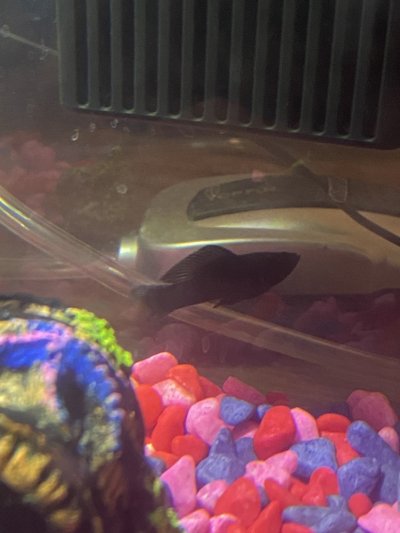
Is it possible one of my mollies could have tried to eat them after they died ? It had been a week and a half between the clean and the fish dying.
I will set an alarm on my phone to do a weekly change as sometimes I only do it bi-weekly bc of a busy schedule. I’ll make the time for it.
What exactly do you mean by change filter media one at a time?
When I wash the filter in the bucket of tank water, is it just a light ‘scrub’ ? If there is a good video example I would really appreciate that, I do better with visual demonstrations!
Attachments
Ive taken a look at information about your filter online. I cant find a good video or a user manual for your specific filter.
Just to support what colin has explained colonies of micro organisms grow in your filter and these colonies consume waste in the water and keep your water from becoming toxic. Every time you change a cartridge you throw away these colonies, your filter loses the ability to consume ammonia and you have to start over growing a new colony. Most cartridge type filters have 2 or more cartridges, so when you have to change a cartridge you only change 1 at a time so you dont throw away all your micro organisms in one go. From what little information i can find your filter is a single cartridge filter and this wont work.
And.
The filter cartridges for your filter contain zeolite. Zeolite chemically absorbs ammonia, so it is chemically doing what these organisms would be doing biologically. Zeolite will give you the appearance of being cycled without being cycled. This is where sales ploy comes in. Zeolite can only do so much before it gets used up, so you need to regularly change these cartridges to get new zeolite into the filtration. If the zeolite gets used up, ammonia will spike because you arent cycled, and cause sickness in your fish. You become a cash cow to the filter manufacturer always having to replace filters.
Much better to do away with the cartridges, do away with the zeolite, get some proper filter media in your filtration, and cycled properly with micro organisms that can consume ammonia long term without constantly having to change and throw away cartridges.
While i cant find anything useful to show you on your specific filter, here is a good video showing a better setup than cartridges on a similar filter.
https://youtu.be/UFP05dhawsw
What i would do is first is look inside your filter and see if there any space to get some biological media in there alongside or behind the cartridge. Biological media would be ceramic rings, or seachem matrix. Richards video is really a promo for biohome so he always uses biohome as biological media in his videos. If you cant get any biological media in there, then maybe some sponge which also acts as biological media.
Run your filter with this new biological media or sponge alongside the cartridge for a couple of months. This will give your new media time to grow these colonies of micro organisms before you remove the cartridge altogether. If the cartridge gets too dirty and clogged up during this couple of months just rinse it using water taken from your tank, or dechlorinate some tap water and use dechlorinated water to rinse it out, then put the cartridge back.
After 2 or 3 months your ultimate set up should be something like richards video, but get there gradually rather than just changing it all in one go.
When you clean filter media, its just a rinse in water taken from your tank or dechlorinated water. Give the filter housing a wipe down.
The only things that needs to be thoroughly cleaned are any moving parts like impeller, impeller shaft, impeller cap etc. There should be maintenance instructions on how to clean any moving parts in your filters user manual. I do this ever 4 to 8 weeks depending on my mood/ motivation at the time and it helps to prevent wear and tear and reduces how often these moving parts need replacing. I replace these moving parts every 18 months to 2 years too when my filters start to sound a bit rattley.
Just to support what colin has explained colonies of micro organisms grow in your filter and these colonies consume waste in the water and keep your water from becoming toxic. Every time you change a cartridge you throw away these colonies, your filter loses the ability to consume ammonia and you have to start over growing a new colony. Most cartridge type filters have 2 or more cartridges, so when you have to change a cartridge you only change 1 at a time so you dont throw away all your micro organisms in one go. From what little information i can find your filter is a single cartridge filter and this wont work.
And.
The filter cartridges for your filter contain zeolite. Zeolite chemically absorbs ammonia, so it is chemically doing what these organisms would be doing biologically. Zeolite will give you the appearance of being cycled without being cycled. This is where sales ploy comes in. Zeolite can only do so much before it gets used up, so you need to regularly change these cartridges to get new zeolite into the filtration. If the zeolite gets used up, ammonia will spike because you arent cycled, and cause sickness in your fish. You become a cash cow to the filter manufacturer always having to replace filters.
Much better to do away with the cartridges, do away with the zeolite, get some proper filter media in your filtration, and cycled properly with micro organisms that can consume ammonia long term without constantly having to change and throw away cartridges.
While i cant find anything useful to show you on your specific filter, here is a good video showing a better setup than cartridges on a similar filter.
https://youtu.be/UFP05dhawsw
What i would do is first is look inside your filter and see if there any space to get some biological media in there alongside or behind the cartridge. Biological media would be ceramic rings, or seachem matrix. Richards video is really a promo for biohome so he always uses biohome as biological media in his videos. If you cant get any biological media in there, then maybe some sponge which also acts as biological media.
Run your filter with this new biological media or sponge alongside the cartridge for a couple of months. This will give your new media time to grow these colonies of micro organisms before you remove the cartridge altogether. If the cartridge gets too dirty and clogged up during this couple of months just rinse it using water taken from your tank, or dechlorinate some tap water and use dechlorinated water to rinse it out, then put the cartridge back.
After 2 or 3 months your ultimate set up should be something like richards video, but get there gradually rather than just changing it all in one go.
When you clean filter media, its just a rinse in water taken from your tank or dechlorinated water. Give the filter housing a wipe down.
The only things that needs to be thoroughly cleaned are any moving parts like impeller, impeller shaft, impeller cap etc. There should be maintenance instructions on how to clean any moving parts in your filters user manual. I do this ever 4 to 8 weeks depending on my mood/ motivation at the time and it helps to prevent wear and tear and reduces how often these moving parts need replacing. I replace these moving parts every 18 months to 2 years too when my filters start to sound a bit rattley.
Ive taken a look at information about your filter online. I cant find a good video or a user manual for your specific filter.
Just to support what colin has explained colonies of micro organisms grow in your filter and these colonies consume waste in the water and keep your water from becoming toxic. Every time you change a cartridge you throw away these colonies, your filter loses the ability to consume ammonia and you have to start over growing a new colony. Most cartridge type filters have 2 or more cartridges, so when you have to change a cartridge you only change 1 at a time so you dont throw away all your micro organisms in one go. From what little information i can find your filter is a single cartridge filter and this wont work.
And.
The filter cartridges for your filter contain zeolite. Zeolite chemically absorbs ammonia, so it is chemically doing what these organisms would be doing biologically. Zeolite will give you the appearance of being cycled without being cycled. This is where sales ploy comes in. Zeolite can only do so much before it gets used up, so you need to regularly change these cartridges to get new zeolite into the filtration. If the zeolite gets used up, ammonia will spike because you arent cycled, and cause sickness in your fish. You become a cash cow to the filter manufacturer always having to replace filters.
Much better to do away with the cartridges, do away with the zeolite, get some proper filter media in your filtration, and cycled properly with micro organisms that can consume ammonia long term without constantly having to change and throw away cartridges.
While i cant find anything useful to show you on your specific filter, here is a good video showing a better setup than cartridges on a similar filter.
https://youtu.be/UFP05dhawsw
What i would do is first is look inside your filter and see if there any space to get some biological media in there alongside or behind the cartridge. Biological media would be ceramic rings, or seachem matrix. Richards video is really a promo for biohome so he always uses biohome as biological media in his videos. If you cant get any biological media in there, then maybe some sponge which also acts as biological media.
Run your filter with this new biological media or sponge alongside the cartridge for a couple of months. This will give your new media time to grow these colonies of micro organisms before you remove the cartridge altogether. If the cartridge gets too dirty and clogged up during this couple of months just rinse it using water taken from your tank, or dechlorinate some tap water and use dechlorinated water to rinse it out, then put the cartridge back.
After 2 or 3 months your ultimate set up should be something like richards video, but get there gradually rather than just changing it all in one go.
When you clean filter media, its just a rinse in water taken from your tank or dechlorinated water. Give the filter housing a wipe down.
The only things that needs to be thoroughly cleaned are any moving parts like impeller, impeller shaft, impeller cap etc. There should be maintenance instructions on how to clean any moving parts in your filters user manual. I do this ever 4 to 8 weeks depending on my mood/ motivation at the time and it helps to prevent wear and tear and reduces how often these moving parts need replacing. I replace these moving parts every 18 months to 2 years too when my filters start to sound a bit rattley.
Thank you! I will go look at my local pet store and/or pick up some sponges for this! I really appreciate all of the help and you taking the time to explain!
Another issue has come to my concern too.
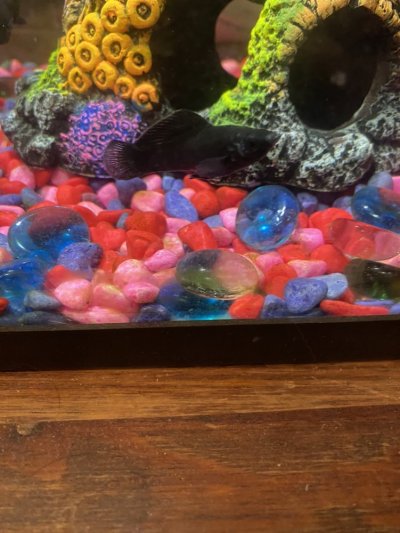
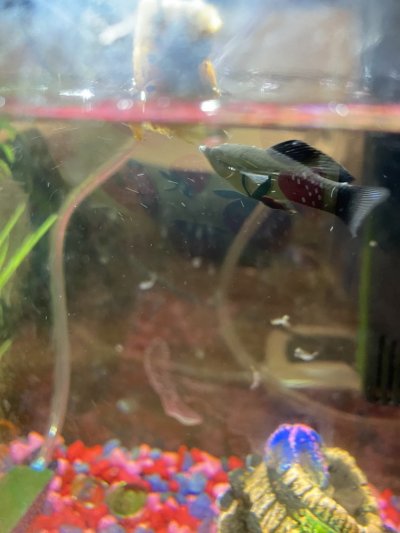
I haven’t introduced any new fish and have fed flakes to them in the meantime, but one of my black mollies developed white spots on one of its sides and two white dots on the top of its head. They are due for a partial water change tomorrow.
Colin_T
Aquarium Advice Addict
The white stuff is excess mucous. Check the water quality and do a big water change and gravel clean the substrate every day for a week. If there's no improvement after a week or water changes, post more pictures.
Make sure any new water is free of chlorine/ chloramine before it's added to the tank.
Make sure any new water is free of chlorine/ chloramine before it's added to the tank.
Similar threads
- Replies
- 17
- Views
- 1K
- Replies
- 8
- Views
- 606
- Replies
- 1
- Views
- 354
Latest posts
-
-
-
-
Nitrates up, pH and total alkalinity down
- Latest: Airborne 82nd
-
-

